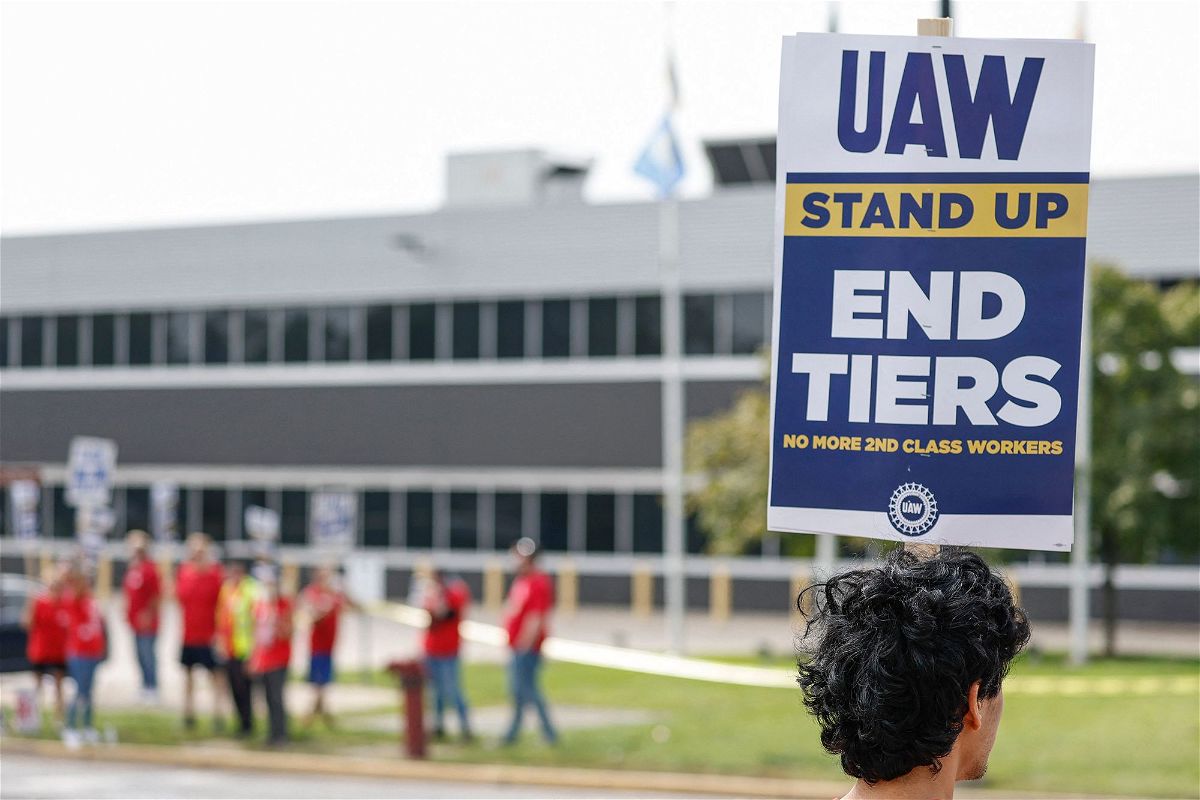GM and Ford lay off almost 900 more workers, blaming strike

UAW members and workers hold signs outside the Ford's Chicago Assembly Plant after walking off their jobs in Chicago
By Chris Isidore and Vanessa Yurkevich, CNN
New York (CNN) — General Motors and Ford are laying off almost 900 additional workers between them, blaming the expansion of the strike announced by the United Auto Workers union at those companies on Friday.
General Motors said it was laying off 164 workers at stamping plants in Parma, Ohio, and Marion, Indiana. Those plants normally send their stamped metal parts to the assembly lines that have been shut by the strike – the plants in Wentzville, Ohio, and the Lansing Delta Assembly plant in Lansing, Michigan. Among the vehicles made at those plants are Chevrolet Colorado and GMC Canyon pickups and the Chevy Traverse and Buick Enclave pickups.
Most of the workers in Parma and Marion will continue to stay on the job, though, producing stamping for other plants, as most GM assembly lines continue to operate.
“We have said repeatedly that nobody wins in a strike, and this is yet another demonstration of that fact,” said GM’s statement. “We will continue to bargain in good faith with the union to reach an agreement as quickly as possible.”
The company had previously laid off more than 1,800 workers at its Fairfax assembly plant in Kansas City, Kansas, as well as its Toledo engine plant and its Lockport components factory in New York state. It has now laid off nearly 2,000 workers across the five affected plants.
Ford, as of Wednesday evening, has laid off approximately 1,300 employees since the strike began.
On Wednesday, Ford said it was laying off an additional 400 workers from two plants, taking effect Thursday. The lay offs affected about 350 workers at Livonia Transmission Plant and 50 employees at Sterling Axle Plant in Michigan.
“These are not lockouts. These layoffs are a consequence of the strike at Chicago Assembly Plant, because these two facilities must reduce production of parts that would normally be shipped,” Ford spokesperson Dan Barbossa said.
Previously, Ford said it laid off 330 workers at its Chicago Stamping Plant and Lima Engine Plant following the union’s decision Friday to strike its Chicago Assembly plant, which made the Ford Explorer and Lincoln Aviator SUVs.
“Our production system is highly interconnected, which means the UAW’s targeted strike strategy has knock-on effects for facilities that are not directly targeted for a work stoppage,” said the statement from Ford. It had previously laid off 600 hourly workers at the Michigan Assembly plant in Wayne, Michigan who were not on strike.
Stellantis, which makes vehicles under the Jeep, Ram, Dodge and Chrysler brands, did not announce any additional layoffs. But the UAW did not expand the scope of the strike to additional Stellantis locations on Friday, citing progress in negotiations. It had previously announced it had laid off 350 UAW members at its Toledo Machining plant as well as at transmission and casting plants in Kokomo, Indiana.
The UAW pointed to its earlier statement criticizing the layoffs.
“Let’s be clear: if the Big Three decide to lay people off who aren’t on strike, that’s them trying to put the squeeze on our members to settle for less. With their record profits, they don’t have to lay off a single employee,” said the union’s statement. “Their plan won’t work. The UAW will make sure any worker laid off in the Big Three’s latest attack will not go without an income.”
The UAW is already paying $500 a week in strike benefits to the more than 25,000 members who are now on strike against the three automakers. The 3,300 members who have been laid off will get $500 a week from the union as well, since in most cases they will not be eligible for unemployment benefits, nor will the companies pay the normal supplemental payments that make up for most of the gap between those state benefits and their normal pay.
Those benefits for both strikers and laid-off UAW members will cost the union about $14.3 million a week, but it went into the strike with $825 million in its strike fund. By having only targeted plants and facilities go on strike, rather than all 145,000 members at the companies, the union is able to stretch out the time it will have the resources to pay members. But it will mean that some members are getting only $500 a week, while about 120,000 continue to get their full pay, at least for now.
Total wages lost by UAW members, before the strike benefits, now come to $325 million during the first two weeks of the strike that started September 15, according to estimates from the to Anderson Economics Group, a Michigan research firm. Analysis by CNN is that that those lost wages have been offset by about $18 million in strike benefits.
Anderson estimates that the automakers have lost $1.1 billion during the strike, from additional facility costs and production costs and lost sales.
In addition the automakers’ suppliers have thus far lost about $1.3 billion, while dealership and customer losses have come to an additional $1.2 billion, bringing the strike’s total cost during its first two weeks to just under $4 billion.
The-CNN-Wire
™ & © 2023 Cable News Network, Inc., a Warner Bros. Discovery Company. All rights reserved.
CNN’s Ramishah Maruf contributed to this report.

